The clinical manifestations of tardive dyskinesia (TD) can be disruptive, with common symptoms including choreoathetotic and stereotypic movements, particularly in the mouth, jaw, tongue, and face. Diagnosing TD is challenging due to its overlap with other dopamine receptor blocking agents (DRBA)-induced movement disorders, such as parkinsonism and acute dystonia, which require different treatments. Diagnostic tools like the Abnormal Involuntary Movement Scale help assess severity, but symptoms may persist or worsen even after stopping the causative medication.
The treatment of TD has improved with the introduction of vesicular monoamine transporter-2 inhibitors, such as valbenazine and deutetrabenazine, which are now first-line therapies due to their proven safety and efficacy. Early detection and careful monitoring are critical to prevent irreversible symptoms. Treatment also involves reviewing the DRBA medication, potentially reducing the dose or switching to atypical antipsychotics like clozapine. For TD with other movement disorders, responses to treatments like botulinum toxin and clozapine may vary. Given the complexities of TD, clinicians must remain vigilant in identifying symptoms and tailoring treatment plans to individual patients.
Reference: Hauser RA, Meyer JM, Factor SA, et al. Differentiating tardive dyskinesia: a video-based review of antipsychotic-induced movement disorders in clinical practice. CNS Spectr. 2022;27(2):208-217. doi: 10.1017/S109285292000200X.


